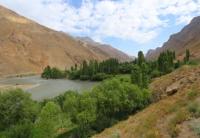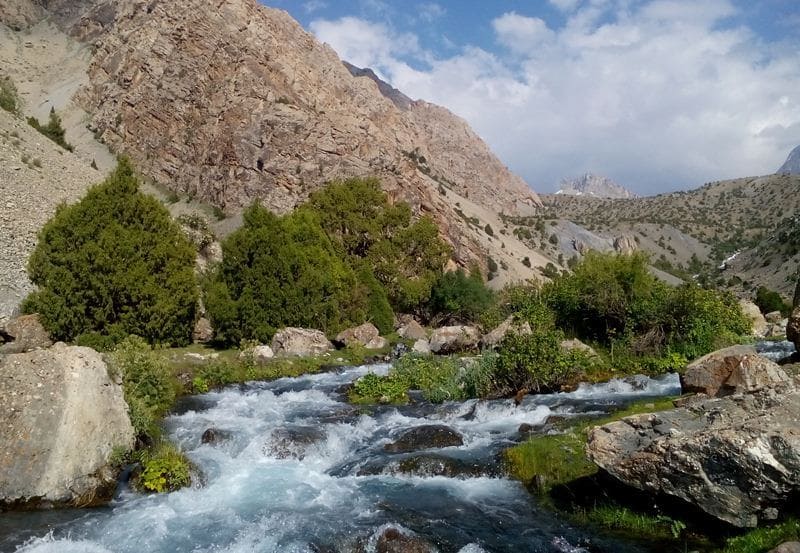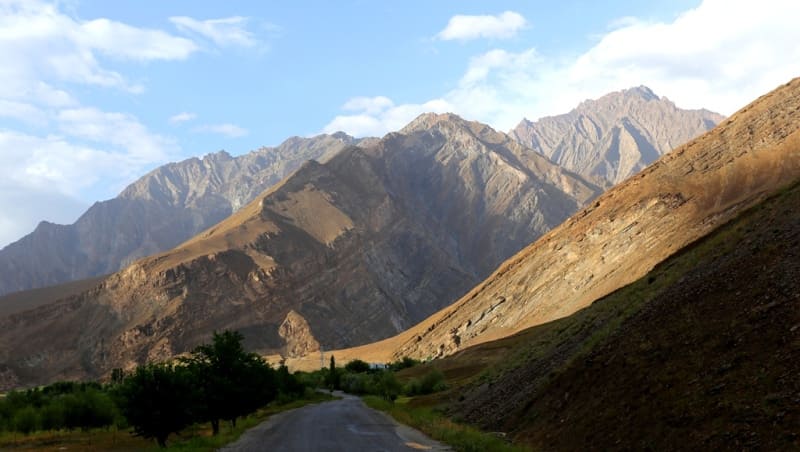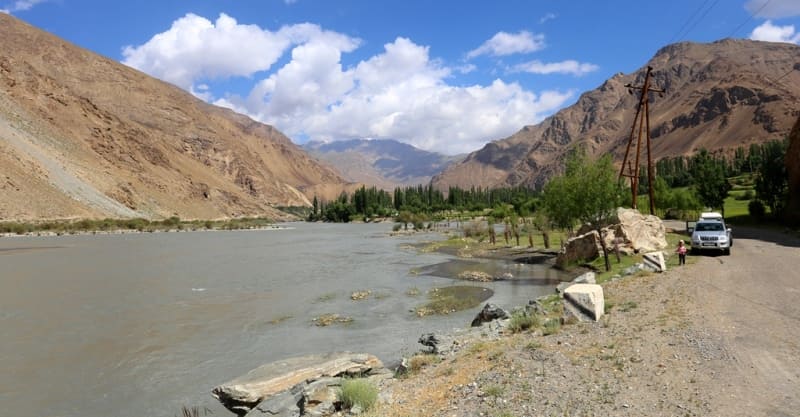You are here
Climate of Pamir-Alai mountain system.

Nature of Kyrgyzstan.
“The steppe has been blooming for centuries and will not bloom soon.
For centuries in the mountains, flowers have been caressing the eyes.
Some come into the world, others are carried away by death,
And the steppe is still the same steppe, and the mountains are the same mountains.”
Baba Tahir. “Both heaven and earth...” End of X – XI centuries.
Natural sights of Kyrgyzstan.
Climate Pamir-Alai is also heterogeneous, although all of it is located in the subtropical zone. The enormous range of altitudes, causing altitudinal climatic zoning, and sharp differences in the distribution of moisture associated with the directions of moisture-bearing air currents and orographic barriers determine climatic contrasts.
In the western part of the Pamir-Alai, on the Gissar ridge, up to 1500 mm or more of precipitation falls per year, and walnut and maple forests grow there, while in the Eastern Pamirs only about 100 mm/year of precipitation falls and is characterized by the most desolate highland landscapes that you can imagine.
The climate of the Pamir-Alai is formed under the influence of: continental tropical air formed in the summer over Central and Central Asia and the neighboring Iranian Plateau; continental air of temperate latitudes, formed in winter over Siberia and Central Asia; cyclones of the Iranian branch of the front of temperate latitudes (in the low-mountain and mid-mountain tiers); constant westerly moist air currents in higher layers of the atmosphere (from an altitude of approximately 3000 meters above sea level).
Due to the peculiarities of atmospheric circulation, precipitation falls in the greatest quantities in the western part of the mountain system and mainly on the western and southwestern slopes, while the eastern slopes and the underlying valleys and plateaus are in the rain shadow.
The contrasts in the distribution of precipitation over relatively short distances are striking. Thus, even in the depths of the mountain system, on the Fedchenko glacier, thanks to the barrier influence of the Academy of Sciences ridge and adjacent ridges that give impetus to precipitation, the annual precipitation reaches 2236 mm, and just a few tens of kilometers to the east, in the regions of the Eastern Pamirs , their number, as we have seen, is negligible.
In the highlands, especially a lot of precipitation falls where latitudinal and sublatitudinal ridges come together to the east, forming a kind of trap for westerly air flows. In such places large glaciers originate (Zerafshansky, glaciers in the upper reaches of the Obihingou-Garmo river,
Despite the sharp differences in the relief of the Western and Eastern Pamirs (they will be discussed below), the Pamirs clearly act as an integral orographic unit, the commonality of which is manifested in the eccentric location of the highest altitudes (K.K. Markov, 1935), i.e. elevation of mountains along the outskirts of the Pamirs.
And if later research revealed that in its natural features the Eastern Pamirs differ sharply from neighboring mountainous regions, in particular the Western Pamirs, then, it would seem, there should have been only one conclusion from this - to single out the Eastern Pamirs as a special physical-geographical region , without causing any confusion in the use of geographical names.
We must also keep in mind the dismemberment of the eastern edge of the Pamirs - the Kashgar Mountains and note that the name “Eastern Pamir” is used rather conventionally, only in relation to our territory of the Pamirs; if we take the Pamir Plateau as a whole with its foreign eastern part (with the Kashgar Mountains), then a certain symmetry will be restored and the Eastern Pamir will become rather Central, as some Soviet researchers call it (K.K. Markov, O.E. Agakhanyants).
The heavily glaciated ridge of the Trans-Alay Range (Lenin Peak, 7,134 meters above sea level) rising in the north of the Pamirs significantly exceeds the Alai Range and other ridges of the Gissar-Alai system stretching to the north.
N.L. Korzhenevsky calculated that in terms of the average height of the ridge, the Trans-Alai ridge exceeds even the ridge of the Academy of Sciences and is thus the highest ridge of the Pamir part. In the eastern part of the Trans-Alai Range, through the notch of the Kyzylart Pass, a road was laid leading into the Eastern Pamirs and further to the west, to Khorog (Osh - Khorog highway). The Trans-Alai Range, which belongs to the outer tectonic zone of the Pamirs, is composed of Meso-Cenozoic strata.
On its northern slope and at the foot, gypsum karst is quite widespread. The internal territory of the Pamirs, lying south of the Trans-Alai Range, is sharply divided into two parts according to orographic features: the Western Pamirs and the Eastern Pamirs, which we call so conventionally, according to tradition.
The Western Pamirs are characterized by a system of high ridges of southwestern and almost latitudinal extent, separated by deep valleys and gorges. These are the Peter the Great and Darvaz ridges (meaning their eastern segments), as well as the Vanj ridge, connecting in the east with the meridional ridge of the Academy of Sciences; to the south are the Yazgulemsky, Rushansky, Shugnansky and Shakhdara ridges.
The northern of these ridges and the Academy of Sciences ridge belong to the tectonic zone of the Northern Pamirs, the Vanch and Yazgulem ridges belong to the Central Pamirs, and the last three ridges belong to the Southwestern Pamirs.
In the Western Pamirs there is the highest peak of the USSR - Communism Peak, 495 meters above sea level, rising in the Academy of Sciences ridge at the junction of the Peter the Great ridge. This peak rises next to the Fedchenko glacier, the largest in the USSR and one of the largest mountain-valley glacier in the world.
At the junction of the ridges of Peter the Great and the Academy of Sciences, the Pamir firn plateau is located - the remnant of an ancient alignment surface, raised to a height of more than 6000 meters above sea level. Gando and others).
In the middle mountains, under the influence of cyclones of the Iranian branch of the front of temperate latitudes, more precipitation falls on the southern and southwestern sides of the mountains, however, due to the southern exposure, there is more insolation here, so you often see denser forests on the northern slopes.
Mid-mountain and especially low-mountain regions have much in common with neighboring desert areas in terms of the nature of climatic processes. In winter, however, since intrusions of cold air do not extend above 500 - 600 meters, it is warmer in the mountains than on the plains, i.e., a temperature inversion occurs, and with the passage of cyclones and intense precipitation on the southern and southwestern slopes of the mountains, on the northern slopes, foehn phenomena develop.
In the spring, as in the southern deserts, due to increased cyclonic activity, rain often falls, which continues into early summer. The maximum precipitation here is in spring, winter-spring, spring-summer. Drought in the mountains begins only in the second half of summer, since the rains stop here much later than on the plain.
Before the onset of drought, ephemeral vegetation develops in the foothills and low mountains. The duration of drought in the mountains is much shorter than on the desert plains; only August and September are sharply dry. During these months, the vegetation burns out and goes under the snow cover of the winter season, much more dried out than in the Tien-Shan, where the maximum precipitation occurs in the summer and the growing season does not stop until the autumn snowfalls.
Only in the Eastern Pamirs, in contrast to the rest of the Pamir-Alai territory, is there a summer maximum precipitation, which is explained by the influence of circulation processes developing over Tibet (B.P. Alisov, 1956), or by the action of the South Asian monsoon (O.E. Agakhanyants , 1965).
As on the Tien Shan syrts, summer precipitation often falls in the form of cereals and snow. In the foothills of the Pamir-Alai and in the low mountains, winter is relatively short and mild, summer is long, with high temperatures; the amount of precipitation is greater than in neighboring deserts (350 - 700 mm/year).
At altitudes of 1500 - 3500 meters above sea level, the climate already has the characteristic features of a mountain climate, it is cooler and in the predominant part of the territory it is more humid: in these altitude limits there is a zone of greatest moisture and in some places precipitation falls in excess of 1000 and even 1600 mm/year.
In the Eastern Pamirs, the climate is very dry, sharply continental and harsh (at an altitude of about 4000 m, the average January temperature is −20°, July 8°). In the valleys of the Western Pamirs, temperatures are higher (at an altitude of about 2100 meters above sea level, the average temperature in January is −7.4°, in July 22.5°) and, although not as much as in the Eastern Pamirs, it is still very dry (annual precipitation - less than 260 mm); in the highlands of the Western Pamirs there is much more precipitation, especially in the north.
Geographic coordinates of Pamir-Alai mountain system: N39°19'45.98" E70°17'12.23"
Note:
If you are using geographic coordinates for Google Earth or Google Maps navigation systems, you must remove the last two digits from geographic coordinates and " (hundredths of a second) and enter the result in the input line. Example: N51°44'09.67" E72°39'40.81" = N51°44'09 E72°39'40



Authority:
N.A Gvozdetsky, Yu.N. Golubchikov. Series “Nature of the World”, Moscow, “Thought”, 1987.
Photos by:
Alexander Petrov.







